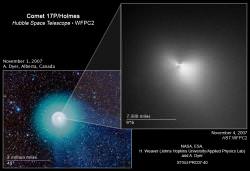All right, here’s the picture we’ve all been waiting for. Step aside ground-based observatories, papa Hubble’s here with images of Comet Holmes, which is now larger than the Sun. But don’t get fooled. That beautiful image on the left was taken by amateur astronomer Alan Dyer from Alberta, Canada. Hubble’s version on the right. It’s not as pretty, but it’s got inner bigness.
You already know the story. Comet Holmes was a boring comet out near the orbit of Jupiter when it flared up on October 23rd. The coma of gas and dust expanded away from the comet, and now it extends to a volume larger than the Sun.
Of course, astronomers scrambled to turn the mighty Hubble Space Telescope to join in on the sky show. The space observatory’s Wide Field Planetary Camera 2 monitored the object for several days, capturing images on October 29, 31 and November 4.
The Hubble image on the right reveals the comet’s nucleus down to a resolution as small as 54 km (33 miles) across. The image was processed to reveal differences in dust distribution near the nucleus.
Astronomers found that there’s twice as much dust along the east-west direction as the north-south direction. This gives the comet a bowtie appearance. Even 12 days after the outburst, when this picture was captured, the nucleus is still surrounded by bright dust.
This isn’t the first time that Hubble has viewed Comet Holmes. Luckily, it actually captured an image back in June 15, 1999. Back then, there was no dust around the object, and Hubble couldn’t reveal the nucleus. By measuring its brightness, astronomers estimated that Holmes is approximately 3.4 km (2.1 miles) across.
Once Holmes settles down again, astronomers will use Hubble to make another accurate measurement of its brightness. By calculating the difference, astronomers will be able to figure out how much mass it lost during this outburst.
Original Source: Hubble News Release


>dust dust dust dust dust come on get with it already
>its charged plasma we live in an electric universe
Perhaps people would take you more seriously if you demonstrated a better grasp of basic punctuation. It may be that you’re such a genius within the field of cosmology that you had no time to learn simple sentence structure, but the odds are against it. An intelligent reader would put your message in the “crank” file and look for more reliable sources of information.
Interesting method of debunking plasma cosmology and the electric universe theories using sentence structure. However if you wish to base your opinion on something other than punctuation you should check out this discussion on the subject.
http://www.abovetopsecret.com/forum/thread322356/pg1